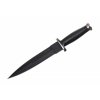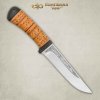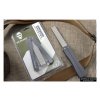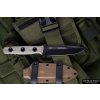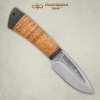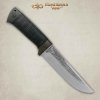Steel is supplied from the BÖHLER Edelstahl GmbH & Co KG plant in Kapfenberg, Austria. It produces incredibly wear-resistant alloys, the so-called "special steels". Although the M390 is one of the most popular steels on the knife market, Böhler developed it for use in molds in the foundry industry. This is what is indicated in the official Böhler steel summary table as the main purpose of use. That the M390 is great for knife blades is considered an alternative target.
Why is M390 steel so popular?
The answer lies on the surface - it's excellent retention of spice. The M390 is so wear-resistant that it retains the desired shape of the cutting edge for a long time. Hence the conclusion that you will not need to sharpen your knife often. Accordingly, the knife will last longer. Obviously, the more often you sharpen a knife, the faster it wears out. Böhler manufactures the M390 using the powder metallurgy method. Typically, a manufacturer combines different elements in an alloy that is poured into molds and rolled to form sheets that can be used by knife manufacturers. Böhler, however, takes this process one step further. After connecting these elements, they are placed in a special gas spray machine that sprays the molten steel. As a result, the structure becomes much finer at the molecular level. In addition to retaining cutting ability, the M390 has several other great qualities. For example, this steel can be cured to a fairly high degree without risk of structural failure.
Also M390 is relatively stainless. Due to the large amount of chromium in the composition, there is little chance of corrosion. This is especially noticeable in comparison with other hard steels, which are known for their sharpness, but are easily corroded.
Chemical components:
- Carbon up to 1.9%: found in all types of steel in varying amounts. Decreases toughness, but increases hardness and wear;
- Silicon up to 0.7%: increases steel hardness, improves hardenability;
- Manganese up to 0.3%: enough to increase tensile strength, but not enough to lead to brittleness;
- Chromium up to 20%: again, chromium is found in all types of steel and is used to increase hardness, tensile strength and corrosion resistance through toughness;
- Molybdenum up to 1%. Makes steel heat resistant and more resistant to cutting edge;
- Tungsten up to 0.6%: Usually found where large amounts of chromium are used. Tungsten increases the wear resistance of the knife, compensating for the lack of strength of chromium;
- Vanadium up to 4%: Used for the production of fine-grained steel by heat treatment. Since powder steel depends on the correct distribution of fine grains, vanadium is a must. This is for added wear resistance of the cutting edge.
Disadvantages of the Böhler M390:
Of course, there are also disadvantages. For example, M390 is relatively expensive steel. Not only in terms of price per kilogram, but also in terms of modification. The wear resistance of this steel tells us that it is difficult to machine. Thus, you need more time to change anything in the blade and the abrasives will wear out much faster. Therefore, a knife made of M390 steel is often more expensive than a knife made of other types of steel.
The M390 is also not easy to sharpen. That is, if you only use Arkansas stone, it will not go far. M390 prefers diamond coated stones or ceramics. Preferably at a very fixed angle.

